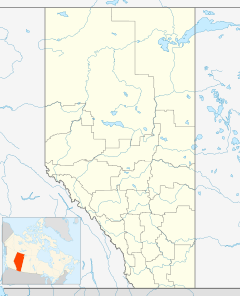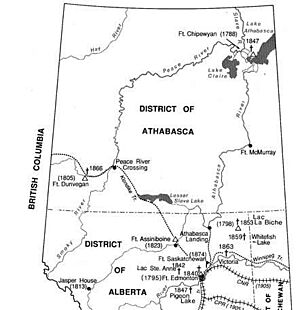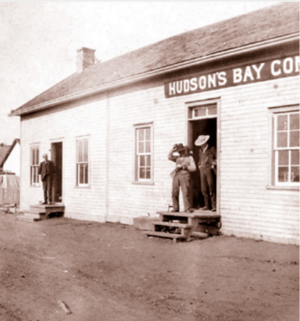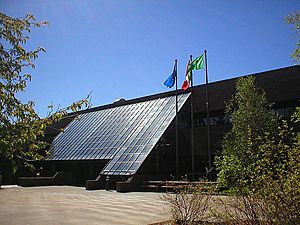Athabasca, Alberta facts for kids
Quick facts for kids
Athabasca
Athabasca Landing (1877–1912)
|
|
|---|---|
|
Town
|
|
| Town of Athabasca | |
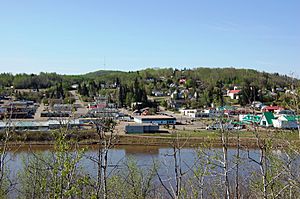 |
|
| Motto(s):
Gateway to the Great New North
|
|
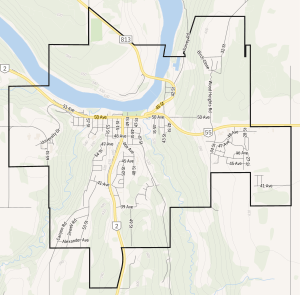
Town boundaries
|
|
| Country | Canada |
| Province | Alberta |
| Region | Northern Alberta |
| Planning region | Upper Athabasca |
| Municipal district | Athabasca County |
| Founded | 1877 |
| Incorporated | |
| • Village | May 18, 1905 (as Athabasca Landing) |
| • Town | September 19, 1911 |
| • Name change | August 4, 1913 |
| Area
(2021)
|
|
| • Land | 17.79 km2 (6.87 sq mi) |
| Elevation | 533 m (1,750 ft) |
| Population
(2021)
|
|
| • Total | 2,759 |
| • Density | 155.1/km2 (402/sq mi) |
| Time zone | UTC−6 (MST) |
| • Summer (DST) | MDT |
| Forward sortation area |
T9S
|
| Area codes | 780, 587, 825 |
Athabasca is a town in northern Alberta, Canada. It is located about 145 kilometers (90 miles) north of Edmonton. The town sits on the banks of the Athabasca River. In 2021, about 2,759 people lived there. Athabasca was originally called Athabasca Landing until 1913. It is the main town in Athabasca County.
Contents
History of Athabasca
What's in a Name?
The name "Athabasca" comes from the Cree language. It might mean "where there are reeds" or "meeting place of many waters." The town was first known as Athabasca Landing around 1889. Its name changed to Athabaska in 1904, then back to Athabasca in 1948. A larger area called the provisional district of Athabasca was created in 1882. This area included parts of what are now Alberta and Saskatchewan.
An Important Trading Spot
Unlike many other towns in Alberta, Athabasca existed before the Canadian Pacific Railway arrived. Athabasca is located on a bend of the Athabasca River. During the fur trade era, rivers were the main way to travel. The Athabasca–Edmonton trail connected two different river systems. The Athabasca River flows north towards the Arctic Ocean. Edmonton is on the North Saskatchewan River, which flows to Hudson Bay.
Athabasca was the end point of the Edmonton to Athabasca Landing trail. This trail allowed goods to be carried between the two river systems. This was very important for trade. Even after people started farming, the trail was still used. Later, roads and railways were built along the same path.
Hudson's Bay Company
In 1876, the Hudson's Bay Company (HBC) built a warehouse in Athabasca Landing. This helped them move supplies to Lesser Slave Lake. By 1886, the site grew to include a store, a house, and a bigger warehouse. It became a full trading post. More buildings were added, like a stable and a workshop. By 1889, it was the main center for the HBC's transport in the north.
Law and Order
The North-West Mounted Police (now the RCMP) sent officers to Athabasca Landing in 1892. This was because more people were using the trail. In 1893, they built a permanent police post.
River Travel
In 1912, the Hudson's Bay Company had two steamboats, the Slave River and the Athabasca River, built in Athabasca Landing. These boats were used for travel on the Athabasca and Peace Rivers.
A Big Fire
In August 1913, a huge forest fire destroyed a large part of the town. About 30 businesses were lost, but thankfully, no one died. The town started rebuilding right away. The HBC post was rebuilt in 1914 and stayed open until 1924.
Learning About the Past
The Athabasca Heritage Society has put up signs around the downtown area and along the river. These signs explain the town's history. They also have a historical walking tour guide available at the town office, library, and visitor center.
Geography and Climate
Lakes Nearby
- Narrow Lake is a lake close to Athabasca.
Athabasca's Weather
Athabasca has a climate with warm summers and cold winters. The hottest temperature ever recorded in Athabasca was 38.3 degrees Celsius (100.9 degrees Fahrenheit) on July 18, 1941. The coldest temperature ever recorded was -54.4 degrees Celsius (-65.9 degrees Fahrenheit) on January 11, 1911.
| Climate data for Athabasca, 1981–2010 normals, extremes 1900–present | |||||||||||||
|---|---|---|---|---|---|---|---|---|---|---|---|---|---|
| Month | Jan | Feb | Mar | Apr | May | Jun | Jul | Aug | Sep | Oct | Nov | Dec | Year |
| Record high °C (°F) | 13.3 (55.9) |
16.1 (61.0) |
20.0 (68.0) |
31.7 (89.1) |
34.4 (93.9) |
34.5 (94.1) |
38.3 (100.9) |
34.5 (94.1) |
32.2 (90.0) |
28.9 (84.0) |
21.1 (70.0) |
15.0 (59.0) |
38.3 (100.9) |
| Mean daily maximum °C (°F) | −8.5 (16.7) |
−4.8 (23.4) |
1.2 (34.2) |
10.2 (50.4) |
16.8 (62.2) |
20.4 (68.7) |
22.7 (72.9) |
21.6 (70.9) |
15.9 (60.6) |
8.7 (47.7) |
−2.3 (27.9) |
−7.2 (19.0) |
7.9 (46.2) |
| Daily mean °C (°F) | −13.4 (7.9) |
−10.4 (13.3) |
−4.3 (24.3) |
3.9 (39.0) |
10.3 (50.5) |
14.3 (57.7) |
16.6 (61.9) |
15.4 (59.7) |
9.9 (49.8) |
3.5 (38.3) |
−6.3 (20.7) |
−11.9 (10.6) |
2.3 (36.1) |
| Mean daily minimum °C (°F) | −18.1 (−0.6) |
−15.7 (3.7) |
−9.7 (14.5) |
−2.3 (27.9) |
3.8 (38.8) |
8.2 (46.8) |
10.5 (50.9) |
9.2 (48.6) |
3.9 (39.0) |
−1.7 (28.9) |
−10.4 (13.3) |
−16.5 (2.3) |
−3.2 (26.2) |
| Record low °C (°F) | −54.4 (−65.9) |
−53.9 (−65.0) |
−43.9 (−47.0) |
−31.7 (−25.1) |
−12.2 (10.0) |
−7.2 (19.0) |
−5.0 (23.0) |
−6.7 (19.9) |
−15.0 (5.0) |
−26.7 (−16.1) |
−45.6 (−50.1) |
−48.9 (−56.0) |
−54.4 (−65.9) |
| Average precipitation mm (inches) | 22.5 (0.89) |
14.9 (0.59) |
17.2 (0.68) |
25.7 (1.01) |
49.0 (1.93) |
87.4 (3.44) |
103.7 (4.08) |
58.1 (2.29) |
37.5 (1.48) |
22.1 (0.87) |
20.6 (0.81) |
20.0 (0.79) |
478.7 (18.85) |
| Average rainfall mm (inches) | 0.6 (0.02) |
0.6 (0.02) |
1.4 (0.06) |
15.5 (0.61) |
46.5 (1.83) |
87.4 (3.44) |
103.7 (4.08) |
58.1 (2.29) |
37.1 (1.46) |
14.1 (0.56) |
1.9 (0.07) |
0.4 (0.02) |
367.3 (14.46) |
| Average snowfall cm (inches) | 21.9 (8.6) |
14.3 (5.6) |
15.9 (6.3) |
10.2 (4.0) |
2.5 (1.0) |
0 (0) |
0 (0) |
0 (0) |
0.4 (0.2) |
8.0 (3.1) |
18.7 (7.4) |
19.6 (7.7) |
111.4 (43.9) |
| Average precipitation days (≥ 0.2 mm) | 8.3 | 6.5 | 6.6 | 6.4 | 9.7 | 14.0 | 15.2 | 12.4 | 10.4 | 7.4 | 7.0 | 8.9 | 112.8 |
| Average rainy days (≥ 0.2 mm) | 0.3 | 0.5 | 0.9 | 4.1 | 9.3 | 14.0 | 15.2 | 12.4 | 10.0 | 5.9 | 1.0 | 0.5 | 74.0 |
| Average snowy days (≥ 0.2 cm) | 8.1 | 6.1 | 5.8 | 2.4 | 0.7 | 0.0 | 0.0 | 0.0 | 0.4 | 1.8 | 6.2 | 8.4 | 39.9 |
| Source: Environment Canada | |||||||||||||
Population of Athabasca
In the 2021 Census, Athabasca had a population of 2,759 people. These people lived in 1,155 homes. This was a small decrease from its 2016 population of 2,965. The town covers an area of about 17.79 square kilometers (6.87 square miles).
Education in Athabasca
Athabasca is home to Athabasca University. This university is a major center for distance education, which means students can learn from anywhere. It is also the town's largest employer.
Media in Athabasca
Local Newspapers
Local news in Athabasca is covered by the Athabasca Advocate. This is a weekly newspaper that has won awards. It started publishing in 1982. The town's first newspaper was the Athabasca Echo, which was published from 1928 to 1986.
Radio Stations
Athabasca has one local FM radio station called Boom 94.1 (FM 94.1, CKBA-FM). It plays classic hits music. The CKUA Radio Network also has a repeater in Athabasca at FM 98.3.
Athabasca in Books and Poems
- The author James A. Michener wrote about pioneers arriving in Athabasca in 1897 in his novel Journey (1989). They came to buy a boat.
- The poet Robert W. Service visited Athabasca in 1911. His visit inspired some of his poems, like The Man from Athabaska and Athabaska Dick.
Famous People from Athabasca
- Bryan Mudryk – A TV personality for TSN.
- Jay Onrait – Also a TV personality for TSN.
- George Ryga – A well-known playwright and poet.
- Kay Heim – A player in the All-American Girls Professional Baseball League.



